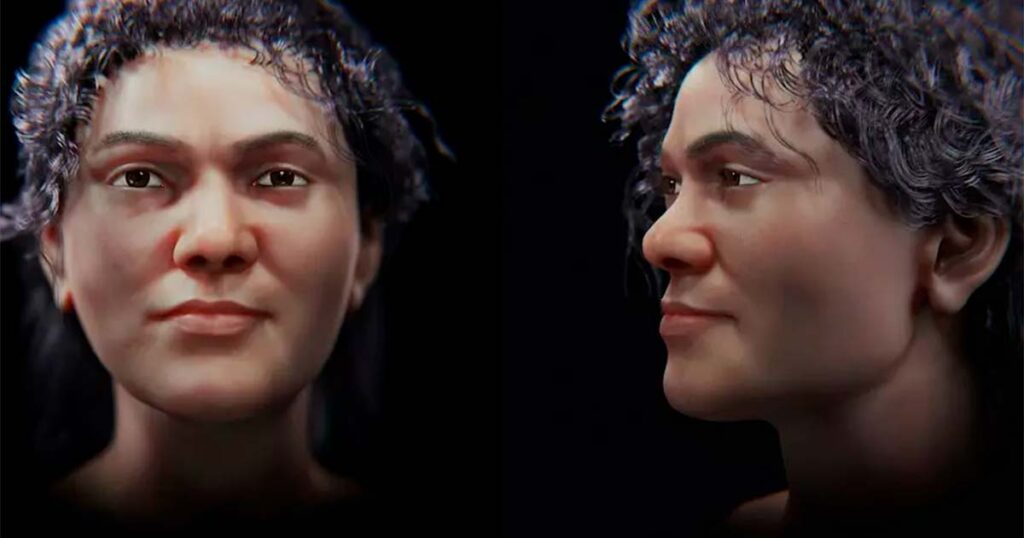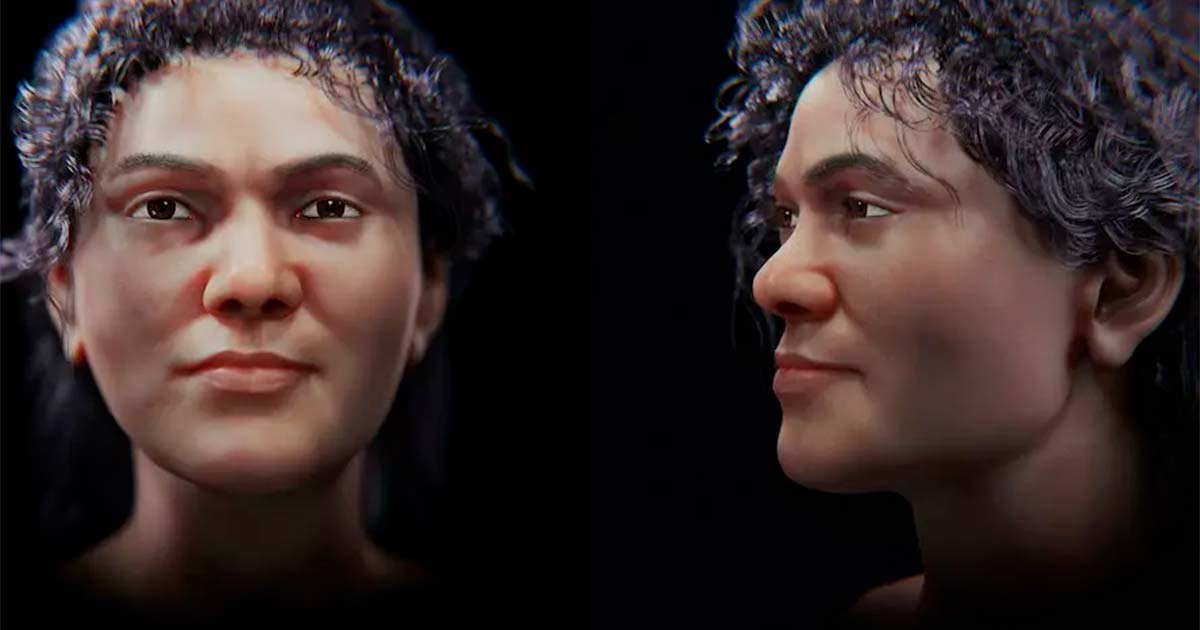

Over 70 years after her severed skull was first discovered buried deep within a cave in the Czech Republic in two different halves, scientists conducted genome sequencing to determine that it was the skull of the same person. It was. Now, this genome sequencing has allowed the first facial reconstruction of ‘Zlatý kůň’, revealing the face of the ‘first modern woman’, for which we have the remains, a woman who walked the Earth some 45,000 years ago!
Oldest Genomic Sequenced Woman from Eurasia
Affectionately known as “Zlatý kůň” or “Golden Horse,” (named so after the mountain in which the discovery was made) she was one of the earliest Homo sapiens to settle in Eurasia after the exodus of the human species from Africa. Her genome contains around three percent Neanderthal ancestry.
An international team of academics from Brazil, Australia, and Italy have brought to life the dark features of this long-gone woman, whose fossilized remains were discovered in the Czech Republic in 1950. Unfortunately, only a partial skull was recovered, suggesting that she may have been preyed upon by an animal after her demise. They published their work online last month in a wonderfully detailed study.
“In 2018, a multinational team of researchers proceeded with the work of three-dimensional reconstruction of the missing regions, using statistical data extracted from a group composed of 31 skulls, 15 of men and 15 of current women, scanned by computed tomography at the Center Hospitalier Universitaire (CHU) of Bordeaux, France, and from the Moča skull, found in Slovakia, dated to 13,100 BP,” the authors of the study write in their paper.
“An interesting piece of information about the skull is that it was gnawed by an animal after her death,” study co-author Cícero Moraes, a Brazilian graphics expert, told Live Science. “This animal could have been a wolf or a hyena ([both were] present in the fauna at that time).”

Skeletal remains of the Zlatý kůň woman. (Kay Prüfer et al./CC BY-SA 4.0)
Recreating Zlatý Kůň: A Digital Deep Dive and Ensuing Results
Despite not having direct access to the ancient skull, the researchers ingeniously employed pre-existing measurements and reference images, a methodology they previously used for this year’s recreation of Tutankhamun’s face. Cícero Moraes was part of that reconstruction as well.
“What most caught our attention was the robustness of the structure [of the face], especially the mandible [lower jaw],” Moraes said. “When [archaeologists] found the skull, the first experts who analyzed it thought it was a man and it’s easy to understand why. In addition to the skull having characteristics that are very compatible with the male sex of current populations. We see that the jaw structure of Zlatý kůň tends to be more compatible with Neanderthals,” he added.
Referred to as a modern human, this particular group exhibited significantly larger brains compared to early humans tracing back to ape-like ancestors. The method employed in this endeavor is called facial approximation, commonly used in forensic studies. It entails predicting a face from a skull without any prior knowledge of the individual’s actual facial appearance during their lifetime.

Stages of forensic facial approximation. (Cicero Moraes et al.)
They found that the endocranial volume, which refers to the cavity housing the brain, was larger in this ancient woman compared to modern individuals in their database. Moraes attributes this intriguing difference in brain size to “a greater structural affinity between Zlatý kůň and Neanderthals than between her and modern humans”.
Moraes disclosed that the team leveraged statistical data collected in 2018 by researchers who initially reconstructed the skull for educational purposes. By combining this data with two CT scans of modern individuals (one male and one female), they were able to craft a digital representation of Zlatý kůň’s face, reports The Daily Mail.
“Once we had the basic face, we generated more objective and scientific images, without coloring (in grayscale), with eyes closed and without hair,” Moraes said. “Later, we created a speculative version with pigmented skin, open eyes, fur and hair. The objective of the second is to provide a more understandable face for the general population.”

The reconstruction including speculative elements of hair, eye color and skin tone. (Cicero Moraes et al.)
The Find of Zlatý Kůň and the Initial Rounds of Genomic Sequencing
In 2021, researchers from the Max Planck Institute for the Science of Human History in Germany made a significant announcement regarding Zlatý kůň. They revealed that this ancient individual lived approximately 2,000 years after the first interactions between Homo sapiens and Neanderthals, marking a crucial point in human history, as per a study published in Nature.
Surprisingly, the DNA from Zlatý kůň and their population does not appear in the genetic makeup of present-day individuals in either Asia or Europe, where Homo sapiens later established their settlements. This finding sets Zlatý kůň apart from other potential contenders as the earliest human fossil in Europe, they revealed.
The evidence gathered by the academics strongly suggests that this individual is much older than other candidates, solidifying her position as a key figure in the story of early human migration and interaction with Neanderthals. Though the genetic data obtained from Zlatý Kůň cannot conclusively reveal much about her facial characteristics, morphological data can provide a reasonable idea of the shape of her head and face. This could be a possible window for this team and others studying her moving forward.